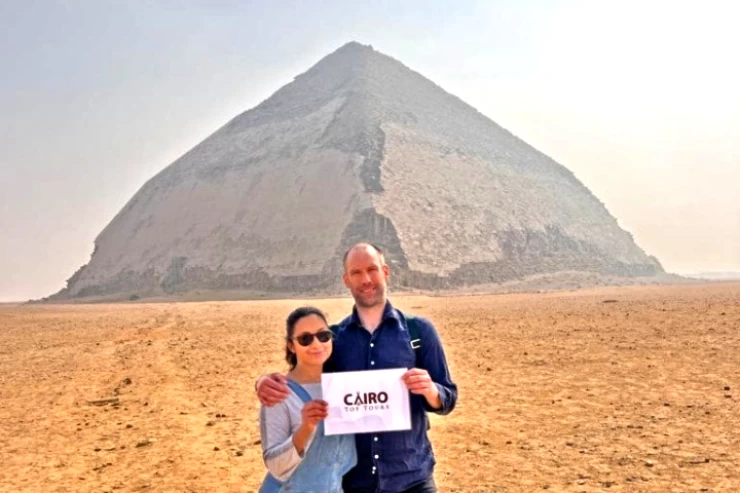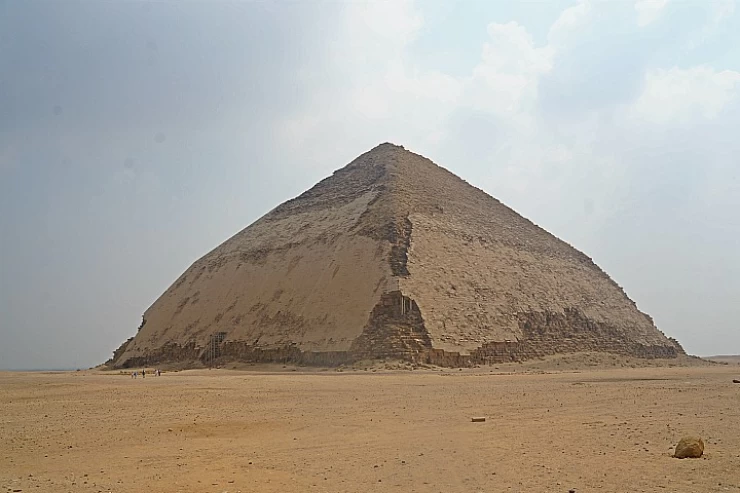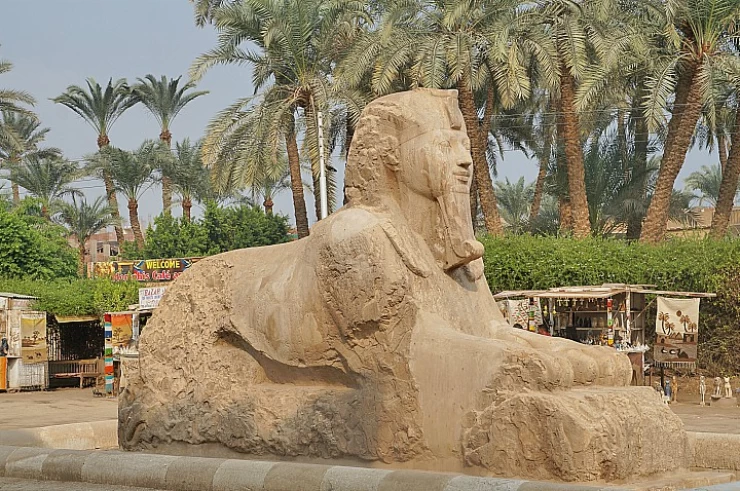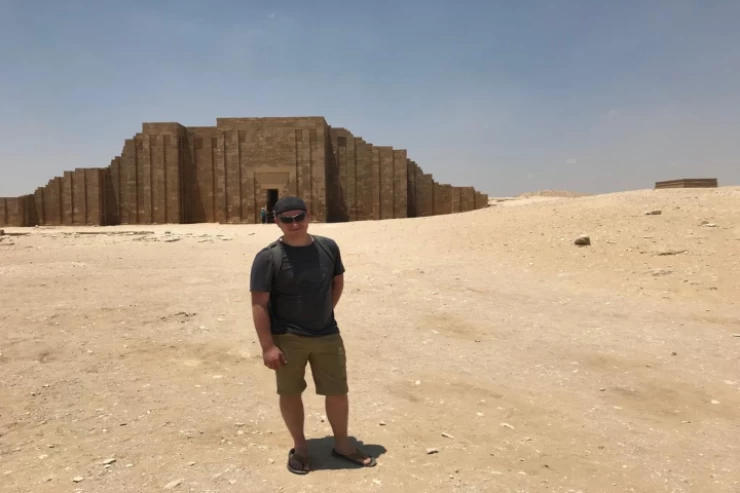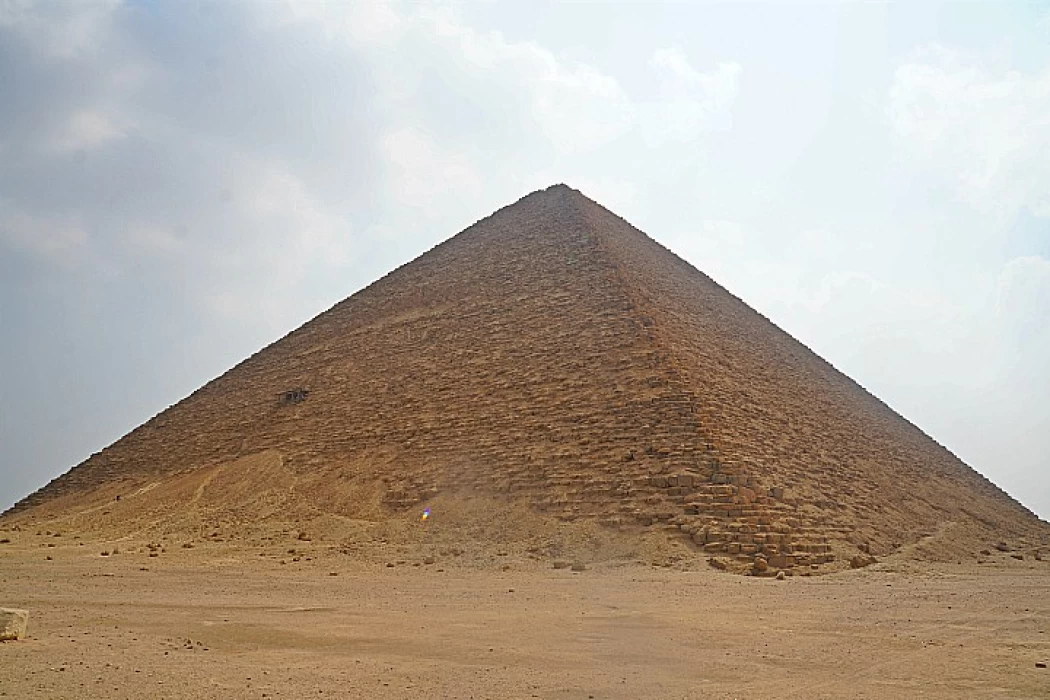
红色金字塔
红色金字塔:埋藏在埃及之下的迷人建筑作品
红色金字塔不仅仅强调它的红色色调,这就是为什么它被赋予红色金字塔标签的原因。 它也是第一个正确建造的,光滑的金字塔,而不是其前身阶梯金字塔,这标志着古埃及建筑的伟大成就,最重要的是金字塔,所有上述挂架都是在之后建造的。
历史背景:Sneferu的建筑遗产
红色金字塔的建造日期为公元前2613-2589年,当时法老Sneferu统治埃及。 这位统治者在历史上因建造了比任何其他埃及法老更多的金字塔而闻名。 建立一个完美的金字塔的愿望可以在他的另外两个主要的金字塔建设努力中看到:Meidum金字塔和Bent金字塔。 然而,这两个早期的,遇到了一些结构问题,Meidum在某个时间点崩溃,而弯曲必须在某个时间点进行设计更改,因为它不是稳定的。
红色金字塔,也被称为北方金字塔,位于开罗以南40公里的达舒尔墓地,与之前建造的其他金字塔相比,它还呈现出更精致的塔状形状。 红色金字塔的建造非常顺利,这要归功于先进的技术和从以前的项目中吸取的经验教训,从而使它成为历史上第一个几何设计没有不规则表面的金字塔。 这将在他的儿子胡夫建造吉萨大金字塔中发挥重要作用,吉萨大金字塔是古代世界七大奇迹之一。
独特的设计和施工
红色金字塔,上升到海拔104米(341英尺)的高度,是埃及第三高的金字塔,仅次于吉萨大金字塔和Khafre金字塔。 它最初比现在的高度高一点,但与许多古埃及建筑类似,随着岁月的流逝,外壳石头被带走,因此高度减少。
很容易,红色金字塔建筑中最突出的元素之一是它具有光滑的侧面,这与传统的金字塔不同,这些金字塔具有上升块的台阶。 然而,金字塔的坡度是43度的浅角度,这使得它相当稳定;这是因为,在经历了倾斜弯曲的金字塔之后,他们知道倾斜的54度斜坡不安全,直到他们改变它的
"红色金字塔"一词来源于建造金字塔时使用的当地石灰石的颜色。 奇怪的是,金字塔首先被抛光的白色土拉石灰石复盖,这将使它在阳光下闪闪发光。 这种外壳的大部分都是随着时间的推移被剥掉的,让里面的红色核心露出来。 在现在,基地的一些白色套管石头仍然可以在现在找到,向参观者展示了金字塔最初是如何建造的。
红色金字塔的巨大尺寸和光滑,尖锐的角落证明了法老Sneferu的古埃及建筑师的辉煌以及他们将金字塔建造发展到最高水平的决心。
探索内部:时光倒流之旅
红色金字塔,不像大多数埃及的俗称金字塔,允许游客去里面,它是最令人兴奋的事情在埃及进入它做的一个。 金字塔坐落在一条蜿蜒62米的通道上,并以地下约27米的角度向下延伸。
完成这条通道后,参观者遇到了三个墓室中的第一个,所有墓室都采用了corbel天花板,以帮助避免通过分配重量来压碎结构。 寺庙非常宏伟,圆柱形屋顶高达12米(40英尺),提供了令人难以置信的开放,并欣赏了可以追溯到古代的建筑技巧。
毫无疑问,金字塔的内部没有雕刻或图案描绘;然而,宏伟和古老的感觉仍然非常清晰。 然而,红色金字塔在很大程度上被认为是为了国王的埋葬,但有人提到他的尸体从未在正确的地方被发现,因此这个金字塔的一些历史是模棱两可的。
红色金字塔背后的工程天才
红色金字塔是古埃及建筑史上的标志性建筑。 在建筑师之后,Sneferu试图建造Meidum金字塔但失败了,在弯曲金字塔的墙壁弯曲之后,熟练的建造者能够应用确保红色金字塔能够经受时间考验的施工方法千
这个金字塔的复合性质有助于其成功。 首先,金字塔的角度不那么陡峭,减少了它下降的机会,使它比弯曲的金字塔更稳定。 在墓室中,corbelled天花板也被用来确保内部结构中的天花板可以容纳金字塔的巨大质量,甚至是内部结构的天花板。 此外,石头的放置,一些重达几吨,清楚地表明埃及的古代文明对科学有很好的理解,可以将其应用于金字塔的结构工程。
红金字塔的建造还涉及先进的采石技术,石灰石是从更近的采石场采购的,大量的劳动力用于移动和放置石头。 虽然他们中的大多数被认为是被招募的工人,但这些工人能够在放置和装配块以形成金字塔方面具有非凡的准确性。
这座建筑引以为豪,展示了埃及的创造力和雄心壮志。 人们清楚地认识到,金字塔不仅是埋葬地,也是人类旅程中建筑奇迹的逃离地。
为旅行者隐藏的宝石
与热闹和大量参观的吉萨金字塔形成鲜明对比的是,红色金字塔以平静和个人的方式欢迎游客。 在Dahshur墓地,一个游客相对较少的区域,使它成为那些希望更和平地欣赏埃及古代历史的人的宝藏。
与吉萨大金字塔的内部相比,爬进金字塔,穿过狭窄黑暗的走廊,进入广阔的墓室,都是完全不同的体验。 红色金字塔更有利于那些有兴趣看古代文明的人,特别是因为它没有被改变或腐败。
红色金字塔在专业摄影师中也有很大的需求,因为它明亮的红色石灰石墙壁设置在灿烂的蓝色天空和金色的沙漠沙滩上。 游客还可以沿着金字塔的一侧往上爬一小段路,这里可以看到达舒尔墓地,其中包括弯曲的金字塔和其他一些墓葬和建筑。
达舒尔墓地:古埃及之窗
红色金字塔位于Dahshour,这是一个古老王国皇室人物和其他建筑的圆锥体墓地。 除了红色金字塔外,Sneferu在Dahshur建造的另一个金字塔是弯曲的金字塔,以其独特的结构而闻名,其角度在施工中途改变。 除了金字塔本身之外,前往达舒尔的游客还可以参观其他古代遗迹,包括较小的金字塔和马斯塔巴斯,这暗示了前埃及王朝时期的活动。
不太发达和商业化的Dahshur不太可能吸引许多游客,但非常适合度假期间的建筑爱好者。 它是历史爱好者和大胆的探险家的地方;人们可以参观金字塔和坟墓,而不会有其他热门旅游地点比比皆是的令人讨厌的游客。
结论:红色金字塔的持久遗产
虽然Sneferu的红色金字塔可能不像吉萨的金字塔那样受欢迎,但它在古埃及建筑中的作用不能被淡化。 尽管它是第一座轮廓光滑的金字塔,但它也是建筑创意和创新的顶峰。
无论是游客还是历史学家,红色金字塔都提供了一个非凡的机会来欣赏古埃及建筑者的非凡创造力,以及法老Sneferu的遗产。 它宁静的环境和令人惊叹的结构形状使它更像是一颗隐藏的宝石,而不是一座巨石雕像的残骸。
如果你对旧工程的发现、金字塔的谜团着迷,或者只是想有一种不同的刺激,红色金字塔会把这个故事带回到埃及有趣的建筑时期之一。 一方面,我们很难错过一个有着数千年历史的令人惊叹的古代世界的影响,它仍然会从观众的体验中唤起一种敬畏之情,特别是在广阔的沙漠和上面的红色金字塔中。
The Red Pyramid not only solely emphasizes its reddish hue, which is the reason why it was given the Red Pyramid tag. It was also the first correctly built, smooth-sided pyramid instead of its predecessor stepped pyramids, which marked a great achievement in ancient Egyptian architecture, and most importantly, the Pyramid, which all aforementioned pylons were built following.
Sneferu's Architectural Legacy . The construction of the Red Pyramid is dated 2613–2589 BC, when Pharaoh Sneferu ruled over Egypt. This ruler is known in history for having built more pyramids than any other pharaoh of Egypt. The desire to build a perfect pyramid is seen in his other two major pyramid-building endeavors: the Meidum Pyramid and the Bent Pyramid. These two earlier ones, however, encountered some structural problems, with Meidum collapsing at some point in time while the Bent had to undergo a design change at some point as it was not stable.
The Red Pyramid, also known as the Northern Pyramid, resides in the Dahshur necropolis, situated 40 kilometers south of Cairo, where it also presents a more delicate tower-like shape as compared to the rest of the pyramids built before it. The construction of the Red Pyramid was remarkably smooth, thanks to advanced technology and lessons learned from previous projects, thus making it the first pyramid in history designed geometrically to be devoid of irregular surfaces. This will play a big part in his son Khufu constructing the Great Pyramid of Giza, which is one of the Seven Wonders of the Ancient World.
The Red Pyramid, ascending to a height of 104 meters (341 feet) above sea level, is the third tallest pyramid in Egypt after the Great Pyramid of Giza and the Pyramid of Khafre. It was originally a little taller than its present height, but similarly to a lot of ancient Egyptian structures, the outer casing stones were taken away as the years went by, hence the reduction in height.
Easily, one of the most outstanding elements of the architecture of the Red Pyramid is the fact it has smooth sides, which is different from the traditional pyramids that had steps of rising blocks. The slope of the pyramid, however, is a shallow angle of 43 degrees, which made it quite stable; this is because, after the experience with the inclined Bent Pyramid, which had an unsafe 54-degree slope until a third of the way up when they changed it, they understood that too much incline was not safe.
The term “Red Pyramid” is derived from the color of the local limestone used in the construction of the pyramid. Curiously, the pyramid was first covered with polished white Tura limestone that would have made it glitter in the sun. The majority of this outer casing was peeled off over the ages, letting out the reddish core inside. In present times, some of the white casing stones at the base can still be found in the present, showing the visitors how the pyramid was originally constructed.
The enormous size and smooth, sharp corners of the Red Pyramid are proof of the brilliance of Pharaoh Sneferu’s ancient Egyptian architects and their resolve to develop the construction of pyramids to the highest level.
The Red Pyramid, unlike most of the popularly known pyramids of Egypt, allows visitors to go inside, and it is one of the most exciting things to do in Egypt to get into it. The pyramid rests on a passage that snakes its way for quite a distance of 62 meters and leads downwards at an angle of about 27 meters underground.
After completing this passage, the visitors come across the first of the three burial chambers, all with corbel ceilings applied to help avoid crushing the structure by distributing the weight. The temples are magnificent, with cylindrical roofs stretching upwards of 12 meters (40 feet), giving an incredible opening and appreciating the skill of construction that dates back ages.
Without a doubt, the pyramid’s interiors are devoid of carvings or pictorial depictions; however, the grandeur and the feeling of antiquity still stand in great clarity. The red pyramid was however largely believed to be meant for the king’s burials, but it’s mentioned that his body has never been found inside the correct place, hence some history of this pyramid is ambiguous.
The Engineering Genius Behind the Red Pyramid
The Red Pyramid is a landmark construction in the history of ancient Egyptian architecture. After the architect, Sneferu tried to build the Meidum Pyramid but failed, and after the bending of walls in the Bent Pyramid, the skilled builders were able to apply the construction methods that ensured that the Red Pyramid could withstand the test of time for thousands of years.
The composite nature of this pyramid contributes to its success. First, the angle of the pyramid, which is not steep so much, lessens the chances of it falling, making it more stable than the bent pyramid. In the burial chambers, corbelled ceilings were also used to make sure that the ceilings in the inside structure could hold up the great mass of the pyramid, even that of the internal structures. Also, the placement of the stones, some weighing up to a few tons, clearly shows that the ancient civilization of Egypt had a great comprehension of science and could apply it in the structural engineering of the pyramids.
The construction of the Red Pyramid also involved advanced quarrying techniques, with limestone being procured from closer quarries and an extensive workforce used to move and place the stones. While the majority of them are believed to have been recruited laborers, these workers were capable of an extraordinary level of accuracy in the placement and fitting of the blocks to form the pyramid.
The structure sits in pride, displaying the creativity and ambition of Egypt. It is a clear understanding that the pyramids were not only burial places but also an escape of architectural marvels in mankind's journey.
A Hidden Gem for Travelers
In sharp contrast to the lively and heavily visited Giza pyramids, the Red Pyramid welcomes its visitors in a calm and personal way. Being in the Dahshur Necropolis, a zone where there are relatively few visitors, makes it a treasure for those who wish to appreciate the ancient history of Egypt more peacefully.
Both climbing into the pyramid and walking through its narrow, dark corridors and entering inside the vast burial rooms are completely different experiences as compared to the interior of the Great Pyramid of Giza, which is often filled with tourists and under strict security. The Red Pyramid is more conducive for those interested in looking at the ancient civilization, especially since it has not been changed or corrupted.
The Red Pyramid is also in great demand among professional photographers because of its bright red limestone walls set against the brilliant blue sky and the golden desert sands. Visitors can also climb a short way up the side of the pyramid, which presents a view of the Dahshur necropolis that includes the Bent Pyramid and a few other tombs and structures.
The Red Pyramid is located in Dahshour, a conic burial ground for royal figures of the Old Kingdom and other structures. Besides the Red Pyramid, the other pyramid built by Sneferu in Dahshur is the Bent Pyramid, noted for its distinct structure with an angle that altered about halfway through construction. Besides the pyramids themselves, visitors going to Dahshur can also visit other ancient remains, including the smaller pyramids and mastabas, which hint at the activities of the pre-Egyptian dynastic period.
Dahshur being less developed and commercialized is unlikely to appeal to many tourists but is ideal for architectural enthusiasts in the vacationing period. It is a place both for history lovers and daring explorers; one can visit the pyramids and the tombs without the annoying presence of tourists that abound in the other popular tourist locations.







